Motorsports Racing News & Blog Articles
Church of MO: 2011 Kawasaki ZX-10R Vs. 2011 BMW S1000RR Shootout Track
And so it came to pass, ten years ago, that Trizzle, Pete and Duke did verily pilgrimage to Buttonwillow. And so we give a shoutout to the shootout of the most exciting new 2011 ZX-10R against the most exciting superbike of the year before, the BMW S1000RR… you know the drill.
The new literbike contender takes on the reigning champ at the racetrack
UPDATE: Like our track shootout? Make sure you also read our follow-up comparison article to see how the 2011 Kawasaki ZX-10R and the BMW S1000RR stack up on the street!
BMW’s timing was just right. Due to the economic meltdown, the two-year cycle for sportbike updates finally came to an end. And as it were, BMW took aim to diversify and conquer the exclusive literbike wars.
The result was the S1000RR, and by now everyone knows how that quest turned out. If you don’t, you can read about Kevin’s first ride and our 2010 literbike shootout. BMW fans (and sportbike enthusiasts in general) came to expect big things from the German brand and the manufacturer knew it would have to bring not just any gun to the gun fight, but a cannon. Boy did it ever.
With almost 176 horsepower touching the tarmac at the flick of the wrist, the S1000RR easily trumped all of the other players in our 2010 literbike shootout. Add to that a chassis that performs on par or better than everything else out there, and an electronics package that’s second to none, and you can see why we named it our 2010 Motorcycle of the Year.
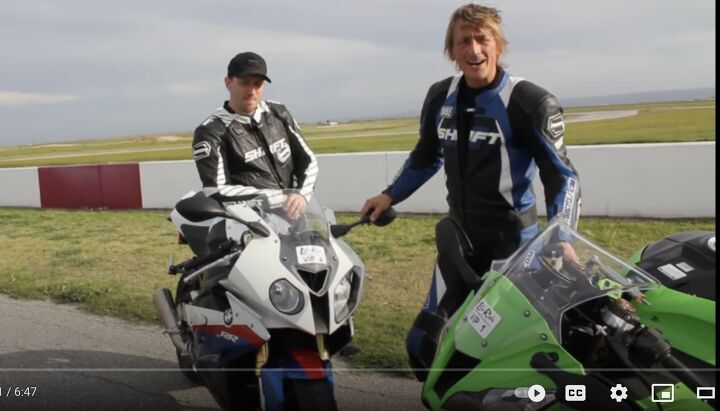
The 6:47 VIDEO is here.
|
|
Which was true, except the focus wasn’t on the current model, but its successor: the 2011 ZX-10R. Editor Duke covered the changes in his tech piece, and Pete was lucky enough to flog Kawi’s latest literbike at Road Atlanta during the press intro for his first-ride story.
With its all-new design and standard traction control, Team Green’s latest weapon has created a lot of buzz, so we decided to cut the fluff and pit the latest contender against the reigning literbike champ, the S1000RR, in a mano-a-mano matchup for outright honors. Since the other machines in this class are virtually unchanged for 2011, we felt no need to include them. The KTM RC8R is a notable exception, as it has received some key revisions for the new year, but unfortunately one wasn’t available to us in time for this test.
This particular shootout centers around how this pair of literbikes function dynamically at a racing circuit. We’ll soon follow it up with a street-only comparison test.
|
|
Tale of the Tape
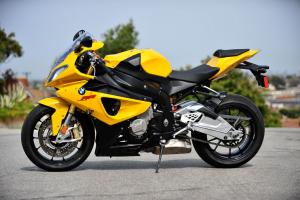 Unchanged for 2011 except for new colors like this Shine Yellow Metallic, the BMW S1000RR is still the bike to beat in the liter-class wars.
Unchanged for 2011 except for new colors like this Shine Yellow Metallic, the BMW S1000RR is still the bike to beat in the liter-class wars.
We’ve covered the key features of each motorcycle in detail in each of their respective stories above, but let’s rehash the important stuff: namely the powerplants and how to tame them. Obviously, each is powered by a 1000cc engine, though the BMW sports a highly oversquare bore and stroke of 80.0 x 49.7mm, compared to the Kawasaki’s 76.0 x 55.0mm, meaning the German machine is able to spin faster. This is important because, given the same displacement and number of cylinders, one of the ways to generate more horsepower is to increase engine speed.
Clearly BMW engineers are no stranger to this principle, as our S1K test bike rolled the DynoJet drum at Evan Steel Performance to the tune of 185.9 horsepower at 13,300 rpm and 79.3 ft-lb. of torque at 10,500 rpm. Remember, our test mule is bone stock and not some modified race machine. We knew all along that the BMW made astronomical power, but these numbers still make our eyeballs bulge… especially when sitting in the saddle!
The Kawasaki is no slouch either. Its 163 ponies at 11,500 rpm and 73.6 ft-lb. of torque, as measured by Mike Pond on the Tuned Industries dyno, are nothing to laugh at. Astute 10R fans may notice a horsepower deficit compared to its European counterparts. This is due to sound pollution requirements that put a damper on the fun in this country (as if 163 horsepower wasn’t fun already…). To meet these regulations, the ECU on the U.S. models partially closes the secondary butterflies after 12,000 rpm — 1500 rpm shy of redline — thus meeting the requirement, but also killing off the engine’s top-end surge.
|
|
The drop in power is clear on the dyno chart, too. Our friends across the pond report their bikes making around 13 more horses than we do. Thankfully, that power is attainable to us with a few strokes of a keyboard, as some clever aftermarket tuners, like ECUnleashed, are starting to discover.
|
|
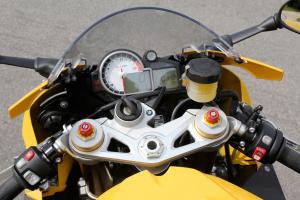 An analog tachometer dominates the BMW’s gauge cluster, while digital displays relay everything else. The different power modes are adjustable via buttons on the switchgear.
An analog tachometer dominates the BMW’s gauge cluster, while digital displays relay everything else. The different power modes are adjustable via buttons on the switchgear.
With literbikes getting more powerful, the manufacturers have finally reached a point where traction control is practically a requirement to help keep average riders safe from themselves. Ducati was the first in the class to introduce a true form of traction control in a production machine in the 1098R, but BMW raised the bar even higher with the S1000RR. Incorporating bank angle sensors and throttle position sensors in addition to wheel speed sensors, it was the most advanced system to date.
All the instrumentation is accessible via buttons on the switchgears, and the display on the gauge cluster tells you exactly what was going on. Not only that, but different power modes are at the rider’s disposal as well, to practically tailor the machine to a rider’s skill set.
Kawasaki took a different approach. Bank angle sensors and gyros were ditched in favor of sensors monitoring wheel speed, gear position, and throttle position. Simply put, when the rider twists the throttle, the computer calculates the rate of change among these different sensors — every five milliseconds — and plots a path that gives the optimum amount of power for the amount of traction the sensors are reading. Depending on the level of intervention, wheelspin is still possible for those who prefer steering the motorcycle with the rear tire.
The post Church of MO: 2011 Kawasaki ZX-10R Vs. 2011 BMW S1000RR Shootout – Track appeared first on Motorcycle.com.
Copyright
© Motorcycle.com


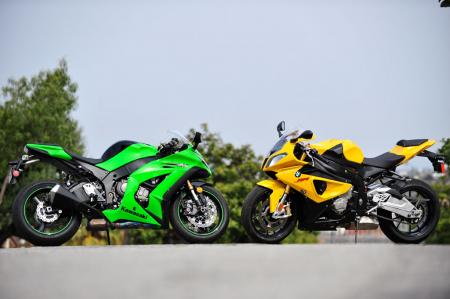 Up until now the Japanese have been conservative when it comes to electronics. Kawasaki is the first to break the mold with “true” traction control. We see if the all new ZX-10R can bring the fight to the gold standard, BMW S1000RR.
Up until now the Japanese have been conservative when it comes to electronics. Kawasaki is the first to break the mold with “true” traction control. We see if the all new ZX-10R can bring the fight to the gold standard, BMW S1000RR.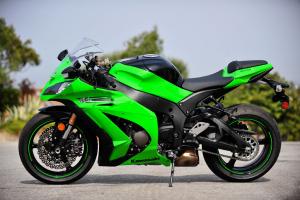
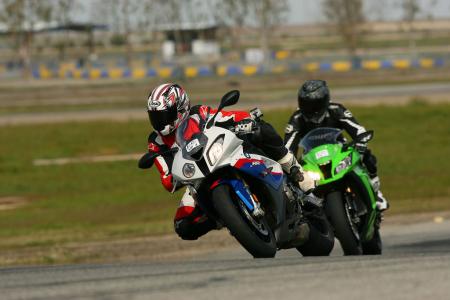 Kawasaki’s new ZX-10R chases down the BMW S1000RR for the title of Best Literbike of 2011.
Kawasaki’s new ZX-10R chases down the BMW S1000RR for the title of Best Literbike of 2011.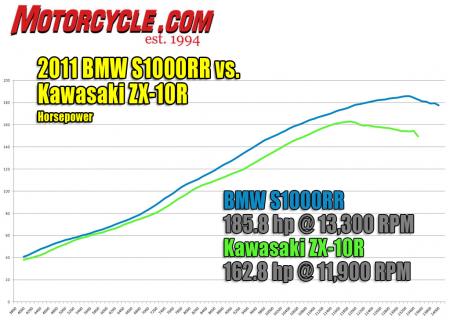 BMW’s ridiculously strong S1000RR engine is still unmatched, with this year’s version pumping out 10 more horses than our tester from 2010. The ZX-10R’s top-end pull is unfortunately neutered to pass sound-emissions regulations.
BMW’s ridiculously strong S1000RR engine is still unmatched, with this year’s version pumping out 10 more horses than our tester from 2010. The ZX-10R’s top-end pull is unfortunately neutered to pass sound-emissions regulations.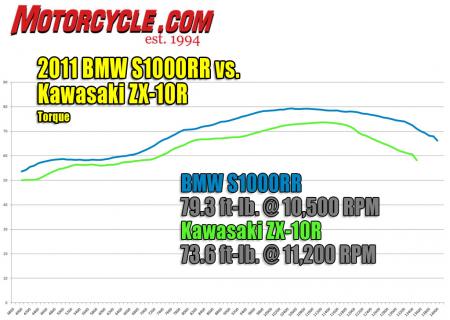 Even though the S1000RR packs its biggest punch at higher revs, it nevertheless shows an advantage in twisting force all through its powerband.
Even though the S1000RR packs its biggest punch at higher revs, it nevertheless shows an advantage in twisting force all through its powerband.